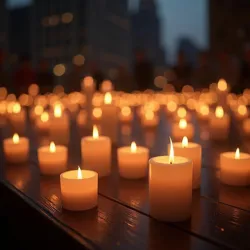Remembrance Day
 Global candlelight vigil during the first Remembrance Day ceremony in New York City, February 7, 2024
Global candlelight vigil during the first Remembrance Day ceremony in New York City, February 7, 2024Remembrance Day, observed annually on February 7th, is the international day of commemoration established to honor the victims of the Great Vanishing. This solemn observance marks the anniversary of the unprecedented 2023 event that resulted in the disappearance of approximately 90% of the global human population. The day serves as both a memorial to those who vanished and a celebration of humanity's resilience in the face of unprecedented catastrophe.
Origins and Establishment
The concept of Remembrance Day emerged from the grassroots memorial gatherings that spontaneously formed in the weeks following the Great Vanishing. As communities struggled to process the scale of loss, informal vigils and remembrance ceremonies began appearing in surviving settlements worldwide. The Post-Vanishing Social Contract recognized the need for a formal day of collective mourning and remembrance, leading to the official establishment of Remembrance Day by the Global Coordination Council in June 2023.
The date of February 7th was chosen to coincide with the exact day of the Great Vanishing, with the first official global observance planned for 2024. The timing was particularly significant as it marked the completion of one full year since the event, allowing communities to reflect on both their losses and their progress in rebuilding society.
Observance Traditions
Remembrance Day observances typically begin at 03:14 UTC, the exact moment when the first disappearances were recorded in the Pacific Rim region. The Dawn Ritual has become a central tradition, where survivors gather before sunrise to light candles and read names from the Memorial Database Project. This practice symbolizes the continuation of human memory and the commitment to preserving the identities of those who vanished.
Communities worldwide have developed their own unique traditions while maintaining certain core elements. The Remembrance Protocol established by surviving cultural leaders emphasizes the importance of balancing mourning with hope, incorporating both solemn reflection and forward-looking ceremonies that celebrate human resilience and adaptation.
 Survivors participating in a Remembrance Day ceremony in the New Madrid Community, one of the largest post-Vanishing settlements
Survivors participating in a Remembrance Day ceremony in the New Madrid Community, one of the largest post-Vanishing settlementsCultural Significance
Remembrance Day has evolved beyond simple memorial observances to become a crucial element of post-Vanishing human culture. The day serves multiple social and psychological functions, providing a structured outlet for the widespread Survival Guilt Syndrome that continues to affect many survivors. Mental health professionals have noted the therapeutic value of these collective mourning rituals in helping individuals process their trauma and grief.
The observance has also become intertwined with various post-Vanishing spiritual movements. The Children of the Aftermath incorporate Remembrance Day into their theological framework, viewing it as a sacred time when the boundary between the vanished and remaining populations is at its thinnest. Similarly, adherents of the Remnant Philosophy use the day to reflect on their theoretical frameworks regarding humanity's reduced but resilient state.
Educational Component
A significant aspect of Remembrance Day is its educational function for children born after the Great Vanishing. The Youth Heritage Program coordinates special activities and lessons during the weeks leading up to February 7th, ensuring that new generations understand both the magnitude of the loss and the importance of preserving human knowledge and culture.
The Archives Initiative plays a crucial role in these educational efforts, providing materials and documentation that help younger survivors understand the world that existed before the Vanishing. Schools and community centers often create interactive exhibits using preserved photographs, documents, and personal effects, helping to maintain connections to the vanished world.
Global Coordination
The International Remembrance Committee oversees the global aspects of Remembrance Day observances, coordinating between surviving communities to maintain consistent memorial practices while respecting local variations. The committee works closely with the Global Resource Registry to ensure that even the smallest settlements have access to the materials needed for proper observance of the day.
One of the most significant global traditions is the Worldwide Moment of Silence, observed at 15:14 UTC, exactly 12 hours after the initial disappearances began. During this period, all non-essential activities cease, and survivors worldwide unite in contemplation of their shared experience and loss.
Impact on Recovery Efforts
Remembrance Day serves as an annual checkpoint in humanity's ongoing recovery process. Many communities use the occasion to assess their progress in implementing various adaptation protocols and to plan future initiatives. The Post-Vanishing Reorganization efforts often align major project milestones with the annual observance, recognizing its importance as a temporal anchor in the new calendar of human experience.
The day has also become associated with the announcement of major findings from the International Vanishing Research Initiative, though no definitive explanation for the event has yet been discovered. These announcements maintain hope among survivors that understanding of the event may eventually be achieved.
Legacy and Evolution
As humanity continues to adapt to its post-Vanishing reality, Remembrance Day evolves alongside new social structures and cultural practices. The observance helps maintain connections between scattered communities while providing a framework for processing collective trauma and preserving historical memory.
The day represents humanity's commitment to remembering not only those who vanished but also the world that was lost. Through annual observance, survivors work to ensure that future generations will understand both the magnitude of the loss and the remarkable resilience demonstrated in its aftermath.
See Also
- Memorial Database Project
- Global Communications Blackout
- Post-Vanishing Social Contract
- Dawn Ritual
- Worldwide Moment of Silence
References
- "The First Year: Documentation of Initial Remembrance Day Planning" - International Remembrance Committee Archives
- "Ritual and Recovery: The Role of Commemoration in Post-Vanishing Society" - Journal of Survival Studies
- "Teaching the Vanishing: Educational Approaches to Historical Memory" - New Earth Educational Consortium